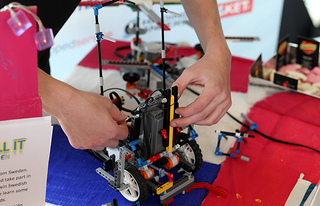AARP Hearing Center
Could a Middle Schooler Cure Alzheimer's With LEGOS?
By Jody Holtzman, December 17, 2012 12:50 AM
http://www.flickr.com/photos/embassyofswedenwashingtondc/8261663153/sizes/m/in/set-72157632219142864/
A little over two years ago, we set out to identify ways for AARP to stimulate innovation in the marketplace that would benefit people over 50. We were and are driven by our mission - to enhance the quality of life for all as we age.
Since then, we have focused on innovation and entrepreneurism by and/or for people 50+. We have created scholarships at DEMO to ensure that startups and older entrepreneurs have an opportunity to pitch their ideas and companies to prospective investors. One of our recent winners, Neurotrack, has a technology that can diagnose Alzheimer's in pre-symptomatic people, opening up therapy design opportunities previously thought impossible. Since being on stage at DEMO, the company has been approached by prospective investors and strategic partners. AARP also has worked to get the attention of startups and venture investors to explore the opportunities presented by the 100 million person market of people 50+, to fund and develop product and service solutions that address their needs and wants. In doing so, we have established relationships with health incubators, VCs and entrepreneurs. One result has been the huge response to AARP's Health Innovation@50+ LivePitch day - where we had 80 startup applicants for 10 slots, to pitch ideas to investors and to AARP members at our recent Life@50+ Event & Expo in New Orleans.
These are just a small example of our efforts. All that aside, I have to say that the most fun thing and promising thing we have done is to sponsor the FIRST LEGO League Seniors Solution competition. FIRST has been around for over 20 years and stands for For Inspiration and Recognition of Science and Technology. The nonprofit was started by inventor Dean Kamen and has programs for kids from 6-18.
Recently, teams in the FIRST LEGO League, in grades 4-8, were given a challenge for the latest competition - find technology solutions that will benefit older people. The challenge is international and will culminate in an international event later next year. But today, at the Embassy of Sweden in Washington, D.C., three FIRST LEGO League teams showed off their stuff - and boy was it great, as were these kids!
One team designed a solution to cure Alzheimer's - an injectable nanobot (a really, really tiny robot the size of the head of a pin) that when it enters the brain of someone with the disease releases an enzyme that dissolves the plaque, and releases stem cells that help grow new neurons. Why didn't I think of that?!? Even more impressive was how much these sixth- and seventh-graders learned about older people, about Alzheimer's, and the empathy they displayed for other people - in this case, ones much older than themselves. It was really wonderful to see.

Another team designed a knee brace to help people with arthritis, that had a motor, and kept the knee warm or cold as required, and made it easier to walk and exercise. The third team created a design for an insole that, utilizing a gyroscope, would help people keep their balance walking up and down stairs.
This was innovation at its best. This was getting kids interested in science, math, engineering, and technology. This was giving kids an opportunity to learn what it is to cooperate in a competitive setting and learn teamwork for a common purpose - a key goal of the FIRST organization. And this was helping kids learn about people and the challenges they face, and recognize that they are agents of change. They can change the world. And they can make it better for everyone of all ages. This was thrilling.































































